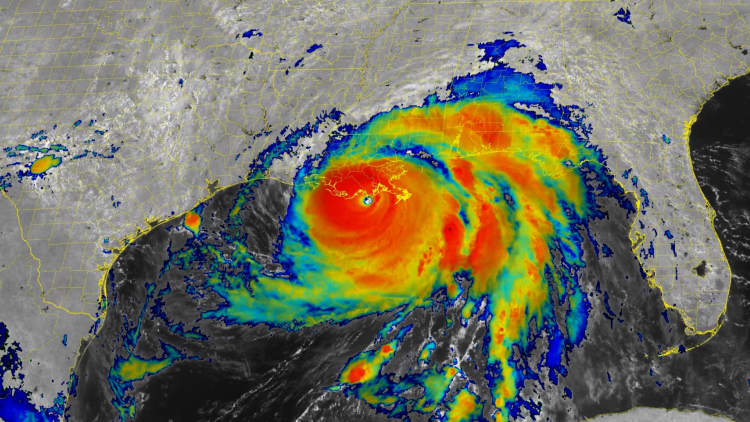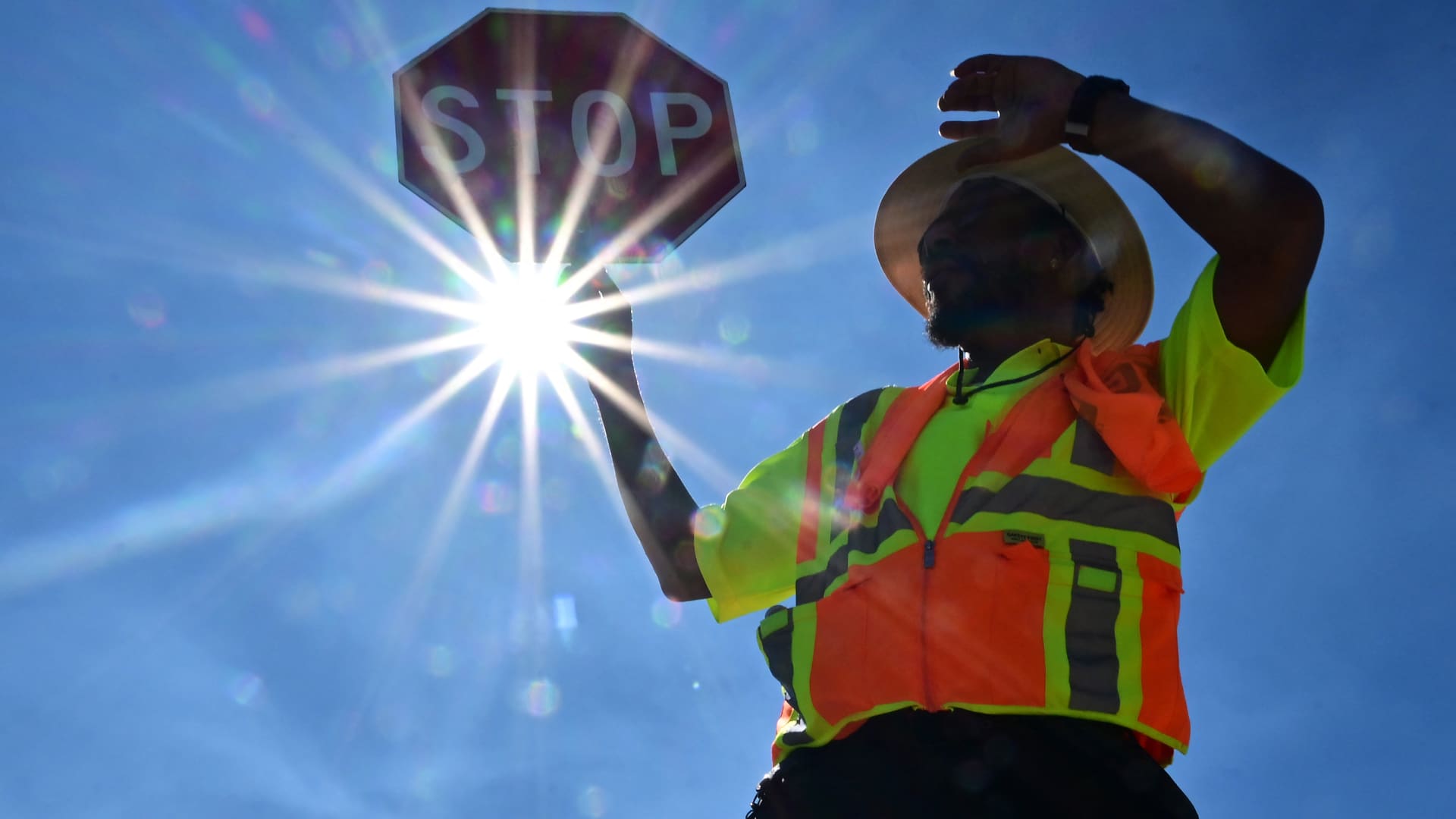[ad_1]
Traffic warden Rai Rogers mans his street corner during an 8-hour shift under the hot sun in Las Vegas, Nevada on July 12, 2023, where temperatures reached 106 degrees amid an ongoing heatwave. More than 50 million Americans are set to bake under dangerously high temperatures this week, from California to Texas to Florida, as a heat wave builds across the southern United States.
Frederic J. Brown | Afp | Getty Images
If you feel like record-level extreme weather events are happening with alarming frequency, you’re not alone. Scientists say it’s not your imagination.
“The number of simultaneous weather extremes we’re seeing right now in the Northern Hemisphere seems to exceed anything at least in my memory,” Michael Mann, professor of earth and environmental science at the University of Pennsylvania, told CNBC.
Globally, June was the hottest June in the 174-year records kept by the National Oceanic and Atmospheric Administration, the federal agency said on Thursday. It was the 47th consecutive June and the 532nd consecutive month in which average temperatures were above the average for the 20th century.
The amount of sea ice measured in June was the lowest global June sea ice on record, due primarily to record-low sea ice levels in the Antarctic, also according to NOAA.
There were nine tropical cyclones in June, defined as storms with wind speeds over 74 miles per hour, and the global accumulated cyclone energy, a measure of the collective duration and strength of tropical storms, was almost twice its average value for 1991–2020 in June, NOAA said.
As of Friday morning, 93 million people in the United States are under excessive heat warnings and heat advisories, the National Weather Service Weather Prediction Center, according to a bulletin published Friday morning. “A searing heat wave is set to engulf much of the West Coast, the Great Basin, and the Southwest,” the National Weather Service said.
A person receives medical attention after collapsing in a convenience store on July 13, 2023 in Phoenix, Arizona. EMT was called after the person said they experienced hot flashes, dizziness, fatigue and chest pain. Record-breaking temperatures continue soaring as prolonged heatwaves sweep across the Southwest.
Brandon Bell | Getty Images News | Getty Images
Flooding in downtown Montpelier, Vermont on Tuesday, July 11, 2023. Vermont has been under a State of Emergency since Sunday evening as heavy rains continued through Tuesday morning causing flooding across the state.
The Washington Post | The Washington Post | Getty Images
On June 27, Canada surpassed the record set in 1989 for total area burned in one season when it reached 7.6 million hectares, or 18.8 million acres. And the total has since increased to 9.3 million hectares, or 23 million acres, which is being driven by record-breaking high temperatures, turning the vegetation into kindling for wildfires to race through.
Those record Canada wildfires have blanketed parts of the United States in smoke, causing some of the worst quality in the world at various points.
A view of the city as smoke from wildfires in Canada shrouds sky on June 30, 2023 in New York City, United States. Canadian wildfires smoke creating a dangerous haze as the air quality index reaches 160 in New York City. People warned to avoid outdoor physical activities and for those who spend time outdoors recommended to use well-fitting face masks when air quality is unhealthy.
Anadolu Agency | Anadolu Agency | Getty Images
In all of 2022, there were 18 separate billion dollar weather and climate disaster events according to data from NOAA, including tornado outbreaks, high wind, hailstorms, tropical cyclones, flooding, drought, heatwaves and wildfires. So far, there have been 12 billion-dollar weather and climate disasters in 2023, according to NOAA.
“This year will almost certainly break records for the number of extreme weather events,” Paul Ullrich, professor of regional and global climate modeling at University of California at Davis, told CNBC.
Global warming is making extreme weather events more severe, scientists said.
“Our own research shows that the observed trend toward more frequent persistent summer weather extremes — heat waves, floods, — is being driven by human-caused warming,” Mann told CNBC.
Ullrich agrees. “Increases in the frequency and intensity of heatwaves, floods and wildfires can be directly attributable to climate change,” Ullrich told CNBC.
Wildfire burns above the Fraser River Valley near Lytton, British Columbia, Canada, on Friday, July 2, 2021. A protracted heat wave continues to fuel scores of wildfires in Canada’s western provinces, with Prime Minister Justin Trudeau calling an emergency meeting of a cabinet crisis group to address the matter.
Bloomberg | Bloomberg | Getty Images
“Through the emission of greenhouse gases, we have been trapping more heat near the surface, leading to increases in temperature, more moisture in the air, and a drier land surface,” Ullrich said. “Scientists are extremely confident that an increasing frequency and intensity of extreme events is a direct consequence of human modification of the climate system.”
Also in June, the weather pattern called “El Niño” arrived.
El Niño is like adding lighter fuel to an already smoldering fire. “Under recently emergent El Niño conditions, temperatures are pushed higher worldwide, further compounding increases in temperature brought on by greenhouse gas emissions,” Ullrich said.
That combination of anthropogenic climate change and El Niño is “spiking some of these extreme events,” Mann said.
Animation of sea surface temperatures for past 6 months
NOAA
El Niño, which means “little boy” in Spanish, happens when the normal trade winds that blow west along the equator weaken and warmer water gets pushed o the east, toward the west coast of the Americas. In the United States, a moderate to strong El Niño in the fall and winter correlates with wetter-than-average conditions from southern California to the Gulf Coast, and drier-than-average conditions in the Pacific Northwest and Ohio Valley.
When global warming and El Niño are hitting at the same time, “it can be difficult separating what is just a weather event or if it is part of a longer trend,” Timothy Canty, professor in the department of atmospheric and oceanic science at University of Maryland, told CNBC.
But what is clear is that climate change makes it more likely that an extreme weather event will happen.
“Higher temperatures from climate change are indisputable, and with each degree increase we’re multiplying our changes of getting an extreme heat wave. In the wetter regions of the world, including the Northeastern US, we’re expecting more rain and more intense storms,” Ullrich told CNBC. “To avoid even more extreme changes, we need to both reduce our reliance on fossil fuels and act to clean up our polluted atmosphere.”
And as long as global greenhouse gas emissions continues to increase, the trend of more and more frequent extreme weather is expected to continue, Mann says.
Decreasing the greenhouse gas emissions released into the atmosphere by burning fossil fuels will help moderate the extreme weather trends.
An infographic titled “Sea ice in Antarctica drops to lowest level in 43 years” created in Ankara, Turkiye on March 01, 2023. The sea ice level surrounding the Antarctic continent has dropped to its lowest level since 1979.
Editorial #:1247611891, Getty Premium
“The good news is that the latest research shows that the surface warming driving more extreme weather events stabilizes quickly when carbon emissions cease. So we can prevent this all from getting worse and worst by decarbonizing our economy rapidly,” Mann told CNBC.
Every person’s contributions to reducing their climate footprint helps, Canty says.
“People have asked me essentially ‘What can I do as an individual that matters?’ and decide not to do anything and instead blame everyone else. Honestly, it’s societies made up of individuals that have gotten us to this point,” Canty said.
Individuals can reduce their greenhouse gas emissions by making small changes like turning off the lights when they’re not in a room, turning down the heat or up the air conditioning when they’re not home, avoiding food waste and using public transportation.
Voting also matters a lot, Canty said. Government leaders have been able to make successful progress on international environmental crises in the past, Canty said, pointing to the Montreal Protocol. “There is a roadmap for working together to fix environmental problems in ways that benefit everyone,” Canty said.
“Tackling the ozone hole required governments, scientists, and businesses to work together and the Montreal Protocol and its amendments have been very successful not only for ozone but for climate,” Canty said, noting that the same chemicals that deplete the ozone, chlorofluorocarbons, are also very bad greenhouse gasses. “The ozone hole is slowly recovering and because of actions taken in the 80s we’ve avoided even worse planetary warming, and we still have air conditioning and hair spray which seemed to be the big panic at the time.”
If individuals and organizations don’t commit to aggressively reducing their greenhouse gas emissions, however, then this battery of extreme weather is a harbinger of the future.
“If we fail to act what we’re seeing right now is just the tip of the proverbial — melting — iceberg,” Mann told CNBC.

[ad_2]






